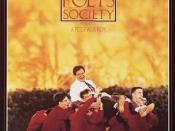The time in which Dead Poets Society is set, late 1959, provides a significant context for understanding the behaviour of its characters.
Post-World War II American lifestyle differed greatly from the previous decades. The war was far behind, the economy was booming, and new technology made life easier. It was around this time that the first stirrings of youthful rebellion appeared against the conformity of the fifties. The Civil Rights movement was gathering momentum, at the same time as the McCarthy era of persecution for "un-American activities" was, mercifully, coming to an end. In most respects American society was, nonetheless, still very conservative and materialistic, and to the country's youth, very boring. Young people sought change while their middle-class families tried to hold them back from being different. The world of Hollywood changed drastically as stars such as James Dean and Marilyn Monroe portrayed characters that were exciting new symbols of rebellion.
James Dean in particular represented the spirit of alienation felt by many adolescents.
These influences are reflected in the personalities of the students in Dead Poets Society, some of whom, such as Charlie Dalton, seemed to be showing signs of rebellion even before Keating began to encourage its further development. They were of an age to become the student radicals of the sixties, and it is easy to imagine some of them going on to do so. The climate of change in the wider society would have been a factor in many of the students embracing Keatings radical ideas with such passion. The environment created by Keating gave them the opportunity to expand their fairly standard adolescent rebellion into a strong belief in the power of non-conformity.


